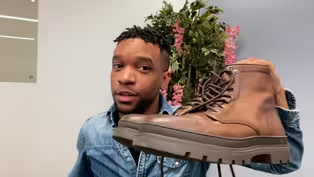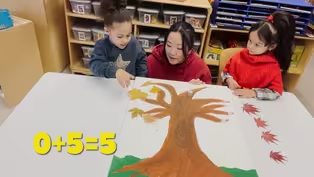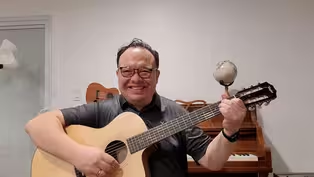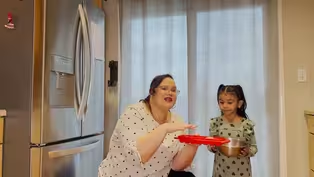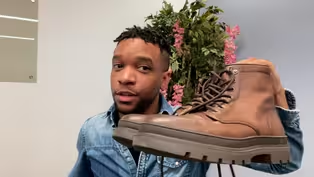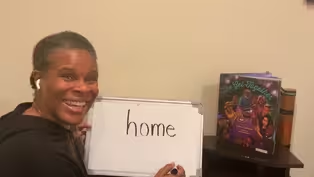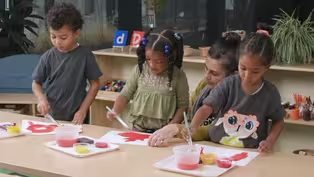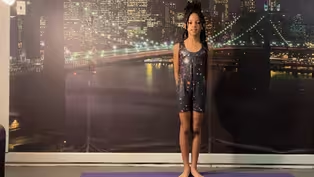
Hope Has a Silent “e”!
5/5/2023 | 56m 3sVideo has Audio Description, Closed Captions
LET’S LEARN about transformation! Turn water into ice and steam. Mix paint colors.
LET’S LEARN about transformation! Turn water into ice and steam. Mix paint to make new colors. See how magic letter e turns short o into long o. Play a game to change the number of leaves on a tree. Read CITY FEET. One-hour programs help children ages 3-7 learn in school and at home. Content provided by Education Through Music, Studio in a School, Sugar Hill Museum Preschool.
See all videos with Audio DescriptionADProblems playing video? | Closed Captioning Feedback
Problems playing video? | Closed Captioning Feedback
Let's Learn is a local public television program presented by THIRTEEN PBS

Hope Has a Silent “e”!
5/5/2023 | 56m 3sVideo has Audio Description, Closed Captions
LET’S LEARN about transformation! Turn water into ice and steam. Mix paint to make new colors. See how magic letter e turns short o into long o. Play a game to change the number of leaves on a tree. Read CITY FEET. One-hour programs help children ages 3-7 learn in school and at home. Content provided by Education Through Music, Studio in a School, Sugar Hill Museum Preschool.
See all videos with Audio DescriptionADProblems playing video? | Closed Captioning Feedback
How to Watch Let's Learn
Let's Learn is available to stream on pbs.org and the free PBS App, available on iPhone, Apple TV, Android TV, Android smartphones, Amazon Fire TV, Amazon Fire Tablet, Roku, Samsung Smart TV, and Vizio.
Providing Support for PBS.org
Learn Moreabout PBS online sponsorship[upbeat music] - [Announcer] Ready to learn?
- Hi.
- Hi, friends.
- [Announcer] It's time to share a story, read, and write.
- Let's take it from the beginning.
- [Announcer] Discover science, sing.
♪ Hello friends ♪ - [Announcer] Play, and so much more.
- We're exploring with light.
- [Announcer] Stay tuned for lessons and activities.
- And the keyword is?
- Apple.
- Awesome!
- [Announcer] Funding for this program was provided by the JPB Foundation.
♪ ♪ - Hi friends, my name is Carlton, and today I am so, so excited to be with all of you.
We're gonna be reading a really, really fun book, City Feet.
The author and the illustrator of this book is Aixa Perez-Prado.
It's a really fun book and I hope you're excited.
Are you ready?
Let's do it, then!
City feet, city feet.
See them walking down the street.
And look at all the different types of shoes!
I see sandals.
I see high heels, I see boots.
I even see some furry looking shoes!
There goes sneakers, clean and new.
Here come loafers, dusty blue.
Slipper feet, chipper feet.
See them shuffling down the street.
Buenos dias, sak pase.
Guten Tag, salaam, good day!
Wiggly feet, giggly feet.
See them bouncing down the street.
Boing, boing, boing.
Gliding by on skateboard wheels.
Slipping on banana peels.
Uh oh, someone fell on the banana!
I hope he's okay.
Hairy feet, scary feet.
See them creeping down the street.
Ooh, I'm getting scared.
Noisy flip-flop flapping by, strappy sandal, heel so high.
That's a pretty high heel.
Snazzy feet, jazzy feet.
See them gliding down the street.
Waiting for the bus in groups.
At the playground, shooting hoops.
Score!
Funny feet, bunny feet.
See them hopping down the street.
Crossing bridges, how are you?
Crossing roads, I'm fine, y tu?
Stinky feet, pinky feet.
See them running down the street.
Hey, wait a minute.
Does he have a hole in his shoe?
Thank you very much, merci!
Playing hopscotch, one, two, three.
Dancing feet, prancing feet.
See them swinging down the street.
Off to work and school and play.
Rapping, tapping through the day.
[Carlton claps] Silly feet, chilly feet.
See them springing down the street.
Standing still to wait in line.
Stopping short to read the sign.
Uh-oh, it says, do not step on the grass!
You better not step on the grass.
Stubby feet, grubby feet.
See them stomping down the street.
Can I see you stomp?
Come on, let me hear you stomp.
[Carlton stomps feet] Good job, friends.
In the sunshine, in the rain, on the bus, and on the train.
And do you see all of those feet?
Look at all those feet on the bus!
Look at the feet on the train!
Tickly feet, quickly feet.
See them skipping down the street.
Buzzing like bumblebees, bzzz.
Jumping puddles, climbing trees.
Okay, friends, I have a secret.
I actually love jumping in puddles.
Don't say anything.
Soccer feet, rocker feet.
See them bopping down the street.
Boa tarde, afternoon, allin tuta, see you soon!
Snoring feet, boring feet.
See them dragging down the street.
Sliding slowly, tiring fast.
Going home to rest at last.
Friends, what are your favorite type of shoes to wear?
Do you love to wear boots?
Do you love to wear sandals?
City feet, city feet.
Snoozing to the city beat.
So I need your help.
I have an activity and I need your help.
Can you help me?
Okay, great.
I'm going on a trip and on this trip, I wanna go to the beach.
So I have sandals and I have boots.
Friends, when I go to the beach, should I wear my boots or should I wear my sandals?
That is correct.
I should wear my sandals to the beach.
But when you go to the beach, you wear sandals.
Awesome job!
Okay, friends, when I go on this trip, I'm gonna go to the park to play.
So when I go to the park, should I bring my sneakers or should I bring my dress shoes?
Sneakers, dress shoes?
I should wear my sneakers!
When you go to the park to play, you wear your sneakers.
Great job, friends, great job.
Okay, on this trip that I'm going on, it might rain.
So, when I go to the trip and it rains, should I wear my dress shoes in the rain, or should I wear my boots in the rain?
That is right, you wear boots in the rain so you don't slip and slide everywhere.
Okay, friends, you have been absolutely amazing.
Amazing, thank you so much.
I think I'm ready for my trip.
Do you wanna come?
[upbeat music] [whimsical ascending music] - Hello, friends.
Today I am transforming into a butterfly!
Do you know what else can transform?
Short and long vowels.
But they have to have help.
In order to change a short vowel like O that says, ah, into its long vowel of O that says, oh, it needs some help.
And the E is always around to give it a hand.
Are you ready to learn about how the magic of E helps the O transform into its long sound?
- [Kids] Yeah!
- Great, let's get started.
[whimsical descending music] Before we get ready to read about the magic of the E, we have to get our ears ready to tell the difference between the short O sound that says, ah and the long O sound that says, oh.
So, get your ears ready with me?
Good, what we're going to do today is we're going to play a game.
It's the stretching game.
So, if you hear the long sound of O, that says, oh, I want you to stretch up high.
And if you hear the short sound of O that says, ah, I want you to shrink as small as you can get.
Are you ready?
Okay, I'm gonna say a word.
You are gonna repeat the word.
We're going to listen for the vowel sound, oh or ah.
And then we're going to stretch or shrink.
The first word is "nope".
Can you say that word?
Nope.
Oh, I hear the, oh, did you?
Good job!
The next word is "pop".
That's right, we're going to shrink.
The next word is "tone".
Yep, good job!
The next word is "stop".
Ah.
All right, are you ready?
The last word is "stone".
Yes, excellent!
You're ready to learn about the magic E and how it changes the O.
Let's get started, yes!
Now we're ready to learn a little bit more about how this E, which I think is magic, will help vowels say their name, specifically help the O say it's long sound of oh.
Are you ready?
So if we have this word, in this word, the vowel sound O is going to be short.
It's going to say, ah.
Ha, ah, p. Hop, hop, right!
But when we add this E, the E will help the O say, it's long sound now of, oh.
But the E remains silent.
Shh, it doesn't make a sound.
So let's build this word together.
Ha, oh, p. Hope?
Hope!
The new word is hope.
I hope you like this lesson today!
Now let's try using this E in a new word.
I know that this is going to be a short sound because it's closed in by the consonant N, so, ka, ah, n. Con, con, it's when someone tries to trick you, right?
Well, what happens when we add the E?
What is our new word going to be now?
Remember, the E, which will be, will help the O say it's long sound of, oh.
ka, oh, n, cone.
Cone, like an ice cream cone!
I see.
Great, now that we've learned a little bit more about how the E can help the O say its name or long sound in words, it's time to read some words that use that skill.
Are you ready?
Here you're going to see three lines of text.
And before we read those lines, I want you to think about what you see.
So let's look at line number one.
What do you notice about these words?
That's great!
Do you know what I noticed?
I noticed that these two words are almost the same, and these two words are almost the same.
That's going to help me when it's time for me to read those words.
Did you see what I see?
You did?
Let's try to read these words together.
Cop, cope, good.
Mop, mope.
Now we're going to look at the second line of text.
What do you notice about these words?
I see these three letters are the same in these words and this word and this word are almost the same.
They only differ by one letter or one sound in this case, one letter, one sound.
Are you ready to read the words?
Let's go.
Woke, I woke up.
Joke, poke, pole, excellent.
Now let's look at the third line of text.
What do you notice that's the same in all four words?
That's right, I see an O, T, E. Those sounds together, remember, the E is silent.
Ote, ote, ote.
That's going to help me, are you ready to read?
Let's go, note, vote, tote, buddy letters, quote, good job!
When I quote someone, I repeat someone verbatim.
That means word for word.
Now that we've practiced reading, it is time for us to read a sentence together.
When I am sad, I mope.
That's an example of moping, that's my example.
Are you ready to go to the next activity?
Here's our last activity of the day.
We are going to write a word together.
So go ahead and get a paper or something to write on and a pencil or something to write with and come on back.
[upbeat music] Now we're going to write a word together.
Are you ready?
- [Kids] Yeah!
- Great, the word we're going to write is "home".
Can you repeat that word?
Great job!
Now let's tap that word out together.
Ha, oh, mm.
Great, now go ahead and write that word right now.
What nice handwriting you have.
Ah, beautiful!
Is this what you wrote?
Ha, oh, mm.
And what helps the O say its name at the end of words?
E, excellent, great job!
Today we have listened for the long O sound and the short O sound, and we've read words and written a word with that magic E that helps the O say oh.
Today, I'd like you to practice playing the stretching and shrinking game with your family members.
Have a wonderful day.
Bye, friends!
[upbeat music] - Hi, my name is Zuri, and today I'm gonna teach you a handstand into a bridge.
First you can go into a racetrack pose or a plank.
Second, you move back a little but not too much.
And third, you can just go back and land.
It's okay if you go back a little and that's how you do a handstand into a bridge.
[upbeat music] - Hello everyone, thanks for watching.
Today, we are gonna learn how to add two numbers to equal up to 10.
Adding means when you take two numbers and put them together and count how many you have all together.
Today, for this activity, we are going to use this tree that we painted.
And as you can see, there are one, two, three, four, five branches on one side, One, two, three, four, five branches on the other side.
And they each have a Velcro square on there.
The other thing we will be using is, I have leaves that I picked from my backyard.
I have five red ones and I have five yellow ones, two different colors.
The last piece that we're using is a modified die, and if you can see it is just a cube with dots from zero to five.
We're gonna start playing our math game.
And today I have two of my favorite people with me.
I have here today.
- Hi, it's me, Ava Luna.
- And I have?
- Renee.
- Renee, so Ava Luna and Renee are going to play this math game.
So they have red leaves in front of them and yellow leaves.
We're gonna show that you that in a minute and we're gonna start.
So we're gonna play an addition game, which means plus we're gonna roll the die, we're gonna take turns, okay?
So here we have our math tree and our leaves.
So, the first thing we're gonna do is Renee's gonna roll the die.
Go roll it and count.
- Two!
- Oh, it's Renee's turn, count how many?
- One, two.
- One, two.
So you're gonna put it on this side, one, two.
Great, all right, Ava Luna, your turn!
Roll the die.
Count how many.
- One, two, three, four, five.
- Five, all right, put 'em on your side.
- Okay, I'll put it.
- One, go ahead, count.
- One, two, three, four, five.
- Great, now, Renee, can you count how many leaves are all together?
Go ahead, Renee.
- There's one, two, three, four, five, six, seven.
- Seven total, right?
So two plus five equals, how many all together?
- One, two, three, four, five, six, seven.
- Seven, so two plus five equals seven.
Great, so can we take the leaves off and play again?
- [Girls] Yeah!
- All right, so Renee, go ahead and roll the die.
Let's see what you get.
What number is that?
- Zero.
- Zero, so do you put any leaves on?
All right, let's see, Ava Luna, What number is that?
- One, one, two, three, four, five.
- Great, let's put on five.
Two.
- One, two, three, four, and five.
- So Renee, you rolled zero.
Ava Luna rolled five.
How many leaves do we have on our board?
- Five.
- Five, great, so zero plus five equals five, awesome.
All right, clear the board.
Go ahead, take them off.
Great job, all right, Ava Luna, you roll first.
What did you roll?
- Nothing.
- What number is nothing?
- Zero.
- Zero.
- All right, Renee, your turn.
Okay, how do you know?
Can you point to each one?
- One, two, three.
- Beautiful.
One, two, three.
Can you point to each one and count them?
- Mm, okay.
One, two, three!
- So three plus zero, Ava Luna, is how many all together?
We have three plus zero equals how many?
Count how many total we have there, - One, two, three.
- Great, all right, we're gonna play two more rounds and then we're gonna stop.
What number is that?
- It's one, two, three, four.
- Okay, so let's put on that number of leaves.
- Wait a second, okay.
One, two, three, four.
Going to add to this side.
- It's gotta go on this side.
Hmm, where is there an extra Velcro?
Let's look.
- It's right there.
- Helping.
Okay, all right, make sure you put four down, count.
- 'Kay, one, two, three, four.
- All right, your turn, Ava Luna.
- One, two, three, four.
- Ooh!
- You got some too.
You got four, woohoo!
- All right, double check, count how many leaves?
- One, two, three, four.
- All right, so how many leaves do we have altogether, Ava Luna?
Can you count how many are on the tree?
- One, two, three, four, five, six, seven, eight.
- Can you double check and touch each one and count them?
Go ahead.
- Okay, one, two, three, four, five, six, seven, eight.
- Great, so four plus four equals?
- Eight.
- Eight, good remembering!
All right, clear the board, take the leaves off and we're gonna play one more round.
- Woohoo!
- Okay, go ahead.
- One, two, three, four?
- Four.
- I gotta do this correctly.
- I'll do it.
I'll get the same.
- All right, double check.
- One, two, three, four.
- Four, your turn.
- Okay, let's do it.
I got one.
- You got one?
Count that loud.
- I got one.
- One, now can you count how many are leaves are on the board altogether?
- Okay, good.
- Go ahead.
One, two, three, four, five.
- Five, good counting together.
So you have four plus one equals?
- Five!
- Thanks for watching, bye!
- [All] Bye!
- Thanks for playing our game!
- Thanks, Renee and Ava Luna.
[upbeat music] - Hello, my name is Elisa Oviedo and this is my niece.
What's your name?
- Zoe.
- Zoe, how old are you?
- Five.
- That's awesome.
Okay, Zoe, so today I would like to talk about liquids, solids, and gases.
I'd like to talk about states of matter with you.
Before we begin, can I ask you a question?
- Yes.
- Where have you seen water before?
- At the pool!
- Yeah, at the pool.
I've seen water there too.
And look, I have some water here in my beaker.
Can I show you two other places I've seen water before?
- Yes.
- Take a look with me at my pictures.
What's this top one?
- [Zoe] Rain.
- [Elisa] Yes.
And what's this one here?
- [Zoe] It looks like a puddle but it's actually a pond.
- [Elisa] Yes, and both of these are examples of?
- [Zoe and Elisa] Liquids!
- [Elisa] Very good, Zoe.
So Zoe, did you know that water is actually a form of matter?
And that matter is anything that can be touched, tasted, or smelled.
- It's all around us.
- Yes, it's all around us.
Matter has volume, which just means it takes up space.
And in science, when we refer to states of matter, what we're actually talking about is the form that the matter is in.
As an example, we have solids and a solid has a consistent shape and a consistent size.
It does not change.
Then, we have liquids which take up a defined volume but do not have a defined shape.
And finally, there are gases which don't have a defined shape or size.
So, I would like to pour my water from my beaker into this container and observe what happens.
Watch as I pour this water into this new container.
What happened?
- It changed the shape.
Because liquid can change shape because it's called a liquid.
- Right, so what I heard you say is because a liquid does not have a defined shape, it just takes on the shape of whatever container we pour it into, right?
- Yeah.
- Okay, so, Zoe, I wanna challenge you a bit, okay?
Right now our water is in a liquid state, but I would like to change it into a solid state.
How can I do that?
- You can put it in an ice tray and then put it in the freezer, but you might have to be patient and wait.
Because when we put it in, especially when it's still a liquid, because liquid it takes a bit of a time before it can be solid.
So you might need to be patient.
- Hmm, so what I heard you say is that if we pour this water into an ice tray, which I happen to have right here, and we put this ice tray into the freezer, it's gonna turn into a solid?
- Yes.
- Why would it do that?
- Because it's too cold for the liquid to stay a liquid.
- Oh, so what I heard you say is that the temperature inside of the freezer is very cold?
- Yes.
- Yeah, and temperature is just the way that we measure how hot or how cold something is.
Can I ask you to do me a favor, Zoe?
Could you pour this water into the ice tray?
[upbeat music] Awesome, okay, Zoe.
So can we make a prediction?
What do you think will happen if we put this ice tray into the freezer?
- It will turn to a solid.
- It will turn into a solid.
Will it happen right away?
- No.
- No, what do we need to do?
We need to give it?
- Time.
- Time.
So after a little bit of time, we are gonna turn this water into a solid.
Would you like to go test your theory?
- Yes.
- All right, come with me.
Oh wow ,look at this, Zoe.
So do you remember the water we had at the table and we put it into the ice tray?
Well, some time has passed now and look what happened.
What happened?
- It turned into ice.
- Yeah, it turned into a solid, right?
Can I show you two other examples of solids?
- Yes.
Okay, take a look with me.
What's this first one?
- Ice, and we made it!
- [Elisa] Yeah, we just made ice.
And this second one?
- [Zoe] Snow.
- [Elisa] Snow, Zoe, and both of these are examples of?
- [Both] Solids!
- Very good, okay, so, Zoe, I have another challenge for you, are you ready?
- Yes.
- I would like to turn this solid into a gas.
How can I do that?
You can put it on the stove and heat it up really hot and it'll come out smoke and smoke is a type of gas.
- So what I heard you say was if we change the temperature, right, because in the freezer it was cold.
- And if you put it on the stove.
- It's gonna be what?
- It is hot.
- Hot, and what's gonna happen to the ice?
It's going to?
- Melt.
- It's going to melt, okay.
So I would love to take this from you, thank you so much.
And now, everyone, I'm going to move over to the stove and say thank you to our Zoe for just a moment.
So we are going to convert or change this solid into a gas.
And what Zoe told us was that if we put it over heat, the ice will melt.
Before we begin, I would like to remind everyone at home to please do this experiment with the assistance of an adult or caregiver, okay?
We also wanna make sure that we are using safety first.
So in this case, the pot is hot and I'm gonna need to use my oven mitts in order to handle the pot.
All right, so first thing I'm going to do is I'm going to place my ice cubes inside of the pot, just like that.
I'm going to put on my oven mitt and I'm going to turn on the stove.
Remember, please do this with the assistance of an adult.
[stove clicks on] All right, so just like how the ice, the water needed time to turn into ice, we need to allow some time for this ice to melt, okay?
When we return, we'll see what happens.
[upbeat music] Okay, so it's been a few minutes and what I am noticing is that the water is beginning to boil.
I wonder what will happen if we leave it on a few more minutes.
Hmm, let's wait and see.
[upbeat music] Okay, Zoe.
So now we're gonna check on our pot.
Again, I'm going to use protection to protect me against the heat from the pot.
I'm gonna turn off the stove, okay?
[stove clicks off] Do you notice anything coming up off the pot?
- Steam.
- Yes, so steam is a form of gas.
Zoe, did you know that?
- No.
Can I show you two more gases I've seen before?
Take a look at these with me, what's this one?
- Fog.
- [Elisa] Fog.
And sometimes you know, Zoe, I've seen fog on a very like cloudy day.
Sometimes it's very foggy outside, have you seen that?
- Yeah.
- And then this one, what's that one?
- [Zoe] We just made it, it's steam!
- [Elisa] Yeah, we just made steam.
And both of these are examples of?
- Gas!
- Gases, very good.
All right, so today, Zoe, we learned about the three states of matter.
We learned about solids, liquids, and gases.
And we also learned that matter is all around us.
Everything is made of matter.
Well, I wanna thank you, Zoe for your help with my science experiment today.
And I wanna thank our friends at home.
Until next time.
- [Both] Bye!
[upbeat music] - Hello everyone, my name Miss Lia.
And today, we are going to paint with the primary colors and transform them to make new colors.
Let's look what we have on the tray to paint with.
I have a paintbrush.
It have bristles in one side.
Those are the little hair that carry the paint, and it has a handle on the other side to hold it.
What else did you see on the tray?
- Colors.
- A sponge.
- Water, water, water.
- [Lia] Water?
- [Kid] Yeah.
- [Lia] To clean the brush.
- [Kid] Yeah.
- [Lia] Sponge?
- Sponge.
- [Lia] To dry the brush.
- [Kids] To dry the brush.
- [Lia] Do you see?
- Color.
- [Lia] Colors?
- [Lia and Kids] Red, yellow, blue.
- These are the primary colors.
And when you mix it, you can make all the colors.
And paper.
Let's try to see what happen when we mix the colors.
Now, I'm going to hold the paintbrush again.
We hold it with the fingers in one side and the thumb in the other just in the middle, like this.
Can we do it?
Try.
Awesome.
- Awesome.
- I think I'm gonna pick yellow.
I dip it once, wipe, I'm ready to paint?
- [Kid] Yes.
- [Lia] Wow, look at this yellow, can I put more?
- [Kids] Yes.
- Dip it once, wipe, wow.
I love yellow.
Now I want to add some blue.
Should I put in?
- [Kids] No!
- [Lia] I don't want to.
I don't want to put any yellow inside the blue.
I need to clean the brush.
So I have a song, do you want to do it with me?
- [Kid] Yeah.
- [Lia and Kids] One, two, three, stop.
One, two, three, stop!
Knock, knock, knock, knock, knock, knock.
Ready?
- [Kids] Yeah.
- [Lia] Yes, wipe one, two, three.
Now I'm ready for blue.
I'm going to dip it once, wipe.
I'm going to put it around.
I want to, wow.
Look at this blue.
- [Kid] And yellow.
- [Lia] Should I mix it with the yellow?
- [Kids] Yes.
- Yes.
- [Lia] What is going to happen?
- [Kids] Green, green, green.
- [Lia] Green, let's try, ah, it turned green!
- Yes!
- [Lia] Wow, look it turned green.
I want to try something.
I want to add more yellow.
Do you think if I add yellow it's gonna be lighter or darker?
- [Kids] Lighter.
- Lighter, let's try it.
What I need to do with my paintbrush?
- [Kids] Clean it, clean it.
- Clean it, one, two, three, stop!
One, two, three, now I'm ready for more yellow.
Dip it once, wipe.
Let's see.
Yes, it is getting lighter.
- I told you it's getting lighter.
- Do you want to try it?
- [Kids] Yes.
- Awesome, let's do it.
I want to see how you hold the brush.
You going, fingers on one side and the thumb in the other.
Wow, you're doing a good job!
Are you ready to paint?
- Yes, I'm gonna start with the blue.
- [Lia] Okay.
- I'm gonna start with the yellow [whimsical music] - Now time to mix it.
- [Lia] Time to mix it.
Wow, that green is fantastic.
Are we ready for the next one?
- [Kids] Yes!
- Okay, you are going to make yellow and red.
I'm going to dip in the yellow.
Can I try the yellow first again?
Dip it once, wipe, and paint a tiny bit on my paper.
- How about you mix the red?
You have to just clean the brush off, and then mix the red.
And then which color is it gonna make?
- We're gonna find out.
Can you help me with the song?
- Yes.
- To clean your brush?
- Yes.
- [Lia and Kids] One, two, three, stop.
- [Lia] Knock, knock, knock.
It's ready.
- [Lia and Kids] One, two, three.
- [Lia] Now dip it on the red.
First, I'm going to draw the red alone.
Oh, look at this red!
Do you like it?
- [Kids] Yeah.
- Are you ready for me to mix them?
What color it's gonna turn?
- [Kids] Orange!
- Orange.
- [Lia] Orange, whoa!
- [Kid] That's orange.
- [Lia] It is orange.
How did you know that it was gonna turn orange?
- Because red and yellow make orange.
- That is amazing.
- Can I put some more yellow here to see what happens?
I think it's your turn, do you want to try it?
- [Kids] Yeah!
- Look, I'm making red to yellow.
- [Lia] That orange is amazing.
- Thank you.
- Now you're ready.
- Yellow.
- [Lia] You put it whatever you want, ah!
- [Kid] I put to this one.
- Now, it's time for red to make orange.
- It's like a fire.
- Mine is getting more lighter.
- [Lia] You are making dots on top of the yellow?
We're gonna try one more pair of primary color to mix.
Can I start with red?
- [Kids] Yeah.
- Okay.
- If you make red with blue, it will turn to purple.
- Do you think it's going to turn purple?
- [Kids] Yeah.
- [Lia] Really?
- Yeah.
- [Lia] I need to try.
So I'm going to wash my paintbrush.
Now I'm going to add blue, wipe, and I'm going to try here.
Ah, how did you know?
That is gorgeous, look at this purple!
Wow, look at this.
This is amazing.
I'm stretching the color with a tiny bit of water to make it more purple because the colors are really strong.
Do you want to try?
- [Kids] Yes!
- [Lia] Awesome, let's do it.
Now we made green, orange, and purple.
- [Kid] Purple.
- [Lia] These are the secondary colors.
Now I wonder, what do you think will happen if we mix the three primary colors all together?
Red, yellow, and blue.
What color do you think it will turn?
- [Kids] I don't know.
- Do you want to try it?
- Yes.
- [Lia] Okay, now it's your turn.
- I'm just gonna get my paint.
- [Lia] Which color are you gonna pick first?
- [Kid] Am I gonna pick yellow?
Look, now time to do blue, and time to mix it.
- Mine is turning to blue!
- Jay, what color is that?
- [Kid] That's yellow-brown.
- [Kid] I made green because I add blue and green.
- [Lia] I like that color.
- Mine is turned to green!
- [Lia] Do the last touch on your painting because we are done.
Now I wonder, Jay, which one was your favorite color to mix?
- I mixed it red and blue.
And it turned into a special purple that I've made before.
That's like a reddish purple.
- Reddish purple, amazing.
- Ava, I made yellow, red, and orange.
- Now how did you make orange?
- With red and with yellow.
- Fantastic, Daphne, what color did you have?
- I made stripes with blue and then it was green and then it turned to with green maybe look like the ocean?
- Did you have yellow and blue?
- Yeah.
- And what color did they make when they mixed together?
- Green.
- [Lia] Green, fantastic.
- [Lia and Kids] Now it's your turn to mix your own colors!
[All speaking in Spanish] [upbeat music] ♪ Hello friends ♪ ♪ Hello friends ♪ ♪ Hello friends ♪ ♪ It's time to say hello ♪ - Hello, everybody and welcome to this music time.
I am so happy, so glad to have you one more time here.
And it is time to say, hello, everybody!
♪ Hello friends ♪ ♪ Hello friends ♪ ♪ Hello friends ♪ ♪ It's time to say hello ♪ - Maybe you have heard some people around that they say hello in a different way.
They say, hola amigos.
Yes, that is Spanish and that is the way we are going to say hello today in Spanish.
Hola amigos, hello friends.
Hola amigos, are you ready?
Let's try to sing it together, here we go.
One, two, go.
[David singing in Spanish] ♪ It's time to say hello ♪ - One more time.
[David singing in Spanish] ♪ It's time to say hello ♪ Yay, it's time for music.
And today we have a special, special game that I want you to play with me.
So I hope you are ready to move to dance, to jump, to learn some new words because this is a special song.
It's a folk Russian song that we are going to sing.
And it has four, I think, three or four special words.
Let's see, say with me, Jimba?
Jimba.
Papaluschka?
Papaluschka.
Papagei, papagei.
And then we will say, la, la, la, la, la.
That was great.
So at the beginning we are gonna say, Jimba, jimba, jimba, papaluschka.
Jimba, jimba, jimba, papagei.
Sing with me.
♪ Jimba jimba jimba papaluschka ♪ ♪ Jimba jimba jimba papagei ♪ ♪ Jimba jimba jimba papaluschka ♪ ♪ Jimba jimba jimba papagei ♪ - And then, then we will use the la, la, la, la, la for the second part.
♪ La la la la la la la jimba papaluschka ♪ ♪ La la la la la la la jimba papagei ♪ ♪ La la la la la la la jimba papaluschka ♪ ♪ La la la la la la la jimba papagei ♪ - Are you ready?
Here we go.
♪ Jimba jimba jimba papaluschka ♪ ♪ Jimba jimba jimba papagei ♪ ♪ Jimba jimba jimba papaluschka ♪ ♪ Jimba jimba jimba papagei ♪ ♪ La la la la la la la jimba papaluschka ♪ ♪ La la la la la la la jimba papagei ♪ ♪ La la la la la la la jimba papaluschka ♪ ♪ La la la la la la la jimba papagei ♪ Woo, for this song, we're going to learn some moves.
Okay, are you ready?
There is a key word.
The key is jimba.
And every time we say jimba, we're going to jump.
Are you ready?
Jimba!
Woo, okay, eyes on me, eyes on me.
Jimba!
Woo, that was awesome!
When we say, papaluschka, this is what we're going to do.
We tap our knees, pa, pa, pa. And then our chest.
Lusch, ka.
Pa, pa, lusch, ka.
Everybody, pa, pa, lusch, ka.
Jimba!
Wow, that was awesome!
And when we say, papagei, we're going to tap, tap our knees, and gei, celebrate.
Pa, pa, gei.
Pa, pa, gei.
Pa, pa, gei.
Woo, that is awesome.
Jimba!
Yay!
Then when we say, la, la, la, la.
La, la, la, la, la, la, la, we're gonna roll our hands.
Like this.
♪ La la la la la la la ♪ Jimba!
Pa, pa, lusch, ka.
♪ La la la la la la la ♪ Jimba!
Pa, pa, gei.
Pa, pa, gei.
Are you ready?
We're going to the to do this together.
Get ready and this is how we take this elements.
Jimba!
Yes, the jumping part.
Our, pa, pa, lusch, ka.
Our, pa, pa, gei.
Our, la, la, la.
And we will transform those moves in a wonderful dance today, you ready?
I hope you're ready to dance and sing with me.
Remember when we say, jimba, we jump.
When we say, papaluschka, pat, pat, chest, chest.
Papagei, pa, pa, gei.
Hey, are you ready?
We're going to do it together, here we go.
One, and two, and here we go.
♪ Jimba jimba jimba papaluschka ♪ ♪ Jimba jimba jimba papagei ♪ ♪ Jimba jimba jimba papaluschka ♪ ♪ Jimba jimba jimba papagei ♪ ♪ La la la la la la la jimba papaluschka ♪ ♪ La la la la la la la jimba papagei ♪ ♪ La la la la la la la jimba papaluschka ♪ ♪ La la la la la la la jimba papagei ♪ - Everybody, here we go!
♪ Jimba jimba jimba papaluschka ♪ ♪ Jimba jimba jimba papagei ♪ ♪ Jimba jimba jimba papaluschka ♪ ♪ Jimba jimba jimba papagei ♪ ♪ La la la la la la la jimba papaluschka ♪ ♪ La la la la la la la jimba papagei ♪ ♪ La la la la la la la jimba papaluschka ♪ ♪ La la la la la la la jimba papagei ♪ Woo, that was amazing!
You guys are great!
That's the way we take elements of movement, of body percussion, songs, and we transform everything into a performance.
My friends, it's time to say goodbye.
Are you ready?
Here we go.
♪ Goodbye friends ♪ ♪ Goodbye friends ♪ ♪ Goodbye friends ♪ ♪ It's time to say goodbye ♪ - Woo!
♪ Goodbye friends ♪ ♪ Goodbye friends ♪ ♪ Goodbye friends ♪ ♪ It's time to say goodbye ♪ - Goodbye, everyone!
- [Announcer] Funding for this program was provided by the JPB Foundation.
[upbeat music] ♪ ♪ ♪ ♪
Video has Audio Description, Closed Captions
Clip: 6/12/2023 | 7m 54s | Carlton Ellen reads CITY FEET, written and illustrated by Aixa Perez-Prado. (7m 54s)
Video has Audio Description, Closed Captions
Clip: 5/5/2023 | 7m 35s | Zoe Kleinmann plays a math game to transform a tree by adding leaves to its branches. (7m 35s)
Video has Audio Description, Closed Captions
Clip: 5/5/2023 | 7m 39s | David Martinez of Education Though Music transforms his body into a percussion instrument. (7m 39s)
CHANGING LIQUID TO SOLID AND GAS
Video has Audio Description, Closed Captions
Clip: 5/5/2023 | 9m 13s | Elisa Oviedo transforms water from liquid to solid. (9m 13s)
Video has Audio Description, Closed Captions
Clip: 5/5/2023 | 7m 54s | Carlton Ellen reads CITY FEET, written and illustrated by Aixa Perez-Prado. (7m 54s)
MAGIC E TURNS SHORT O INTO LONG O
Video has Audio Description, Closed Captions
Clip: 5/5/2023 | 11m 34s | Isabel Simmons transforms short o into long o with the magic letter e. (11m 34s)
TRANSFORMING PRIMARY COLORS INTO SECONDARY COLORS
Video has Audio Description, Closed Captions
Clip: 5/5/2023 | 9m 52s | Lia Zuvilivia from Studio in a School transforms primary colors of paint into new colors. (9m 52s)
ZURI TRANSFORMS A HANDSTAND INTO A BRIDGE!
Video has Audio Description, Closed Captions
Clip: 5/5/2023 | 31s | Zuri transforms a handstand into a bridge. (31s)
Providing Support for PBS.org
Learn Moreabout PBS online sponsorshipSupport for PBS provided by:
Let's Learn is a local public television program presented by THIRTEEN PBS
